Stages of labor
What to expect
Your female will show some of these signs or all of them. If your experience is not normal from things you have read, you should call your vet. Delaying help from a vet could endanger your dam and pups. This is a time to remember to be safe rather than sorry.
First stage of labor:
(This stage often goes unnoticed, and takes place in the 24 hours following temperature drop.)
Temperature FINALLY drops to 98°F from its normal 99, 100, 101°F (you should have been taking it regularly for a few days).
If you are really committed, the temperature taking does work. You will find her temperature around 99 to 101, and as soon as it starts to drop below 99 and continues to drop (now you take it every hour or two) you have about 12-24 hours from the start of the drop. When it bottoms out to 98 or 97.9, then you have about 2-12 hours.
You may find your dam much more restless and not able to get comfortable. She will stretch out on her side.
You may find her eyes different; they will dilate, and she will stare at you.
She may not want you out of her sight. She may go to her whelping box.
She may vomit. She may try to have a bowel movement from the pressure. She may urinate frequently.
She will refuse to eat and seek a quiet spot, like a closet or under a bed.
She may have some mucus discharge, and her vulva area will become puffier.
The normal body temperature for animals is generally higher than for humans. The normal rectal temperature of a dog is 99.5° to 102.5°F. The normal temperature of a puppy at birth is 96-97°F. The temperature gradually increases with age until it is 100°F at four weeks of age.
Second stage of labor:
Your female may go to her whelping box, or couch, or wherever she has chosen to have her pups, and start digging.
She may start shivering and panting, examining her rear, and licking her vulva.
She may have mild contractions, vomiting, pooping and urinating more.
Warning Signs: twitching, green discharge (green discharge is only normal AFTER a pup is born).
At the first sign of a contraction, give her some calcium. Offer her vanilla ice cream, or you can use something such as Calsorb.
Third stage of Labor:
Water sacs present and break
Shivering and panting may continue and get stronger, as well as digging.
Contractions will become stronger and closer together.
Vomiting, grunting and pushing.
Warning Signs: pushing on a pup for over an hour causing exhaustion (more warning signs listed below).
Normal and preferred time to push on one puppy that is in the birth canal is two to ten minutes.
A puppy half out, stuck and breech must be pulled out or it will drown if pushing doesn't get this puppy out within a few minutes.
One must be prepared for some interesting scenarios.
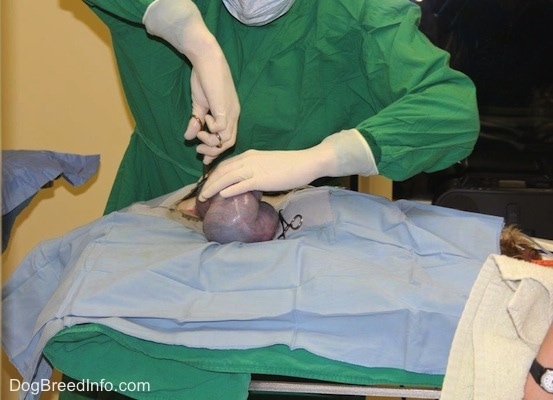
This pictures shows a female dog having a cesarean section. The vet cut the dog open and pulled out the uterine horn full of pups and then cut the pups out of the horn. There was a dead pup in this litter inhibiting a natural birth. There were also 6 healthy puppies.
It is a great tool to do x-rays on day 55/56 to determine size and number of puppies. X-rays can be done sooner, but later gives you more information on puppy size, and knowing that the last puppy is out is comforting. It can also help aid in knowing all puppies look healthy. X-rays may show a large puppy, and then one can anticipate a difficult delivery, and have the vet on call. (He should be on call either way, as you never know what problems may arise, like these large pups getting stuck in the birth canal.) To help the pup along, grip the pup carefully with a clean dry towel, rotate it slightly from side to side and then as the dam has a contraction, pull steadily downwards and across the dam’s belly, toward her head.
I have had a large puppy get stuck in the birth canal (Pelvic Canal Obstruction) and it put the entire litter and dam at risk. In this case, my vet called it "A Puppy Stuck in the Door." The puppy had to come out the birth canal. His head was out and he was breathing (as the dam broke the sac). I had to hold his head to make sure he did not go back in. He was stuck tight, and contractions stopped. My vet’s advice was to get out the dish soap. It worked. All soaped up, I pulled and out he came. Without the dish soap trick, I couldn't pull him out without hurting him—he was just too big for the dam. The dam was so exhausted, she couldn't deliver the rest of her pups, and contractions stopped... So the rest were done by C-section, saving all puppies. But things could go wrong, like the puppy could be breach. A breach puppy that gets "stuck in the door" is often born dead, as it may drown. There could be a pinched cord or any number of other possibilities. If your puppy is stillborn try to revive him or her.... Often they will come back, but often they will not. Keep trying to revive for up to half an hour; it is not uncommon for a puppy to take 20 minutes to come around.
Stuck puppies are VERY common. They come out better with lubrication; the BEST way to get them out is to use a feeding tube and a syringe. Insert the syringe past the puppy and push in K-Y lubricating jelly.
The pup must come out.
It is also helpful to know, YOU CANNOT KILL a dead puppy, so you have nothing to lose, and everything to gain, by being aggressive and TRYING to save a stuck puppy, as if you leave it stuck breach, then it will surely die.
Pre-eclampsia/eclampsia can happen ten days after whelping, but can also happen with a large litter, and more in toy breeds in the last few days of pregnancy. Hypocalcemia shaking and pre-labor shaking can seem the same at first, but if the dam is hypocalcemic and gets eclampsia the shaking quickly turns to convulsions, muscle weakness, muscle tremors, spasms, rigidity and twitching needing immediate vet assistance before seizures, coma and death. It is wise to give your dam calcium when pups are five days old (for the next few weeks). Eclampsia (sometimes referred to as Milk Fever) is a very serious condition, and can come on suddenly. It is caused from a shortage of calcium in the bloodstream.
Uterine inertia can also happen with a large litter or large pups. The dam will fail with weak attempts to deliver the pups. She may not even show contractions as her uterus is too stretched. The biggest cause of this is from too much calcium in the diet while pregnant. It is the way to mess up a breeding. I limit calcium at pregnancy stage and give it at labor stage, and my deliveries are noticeably better, and need fewer C-sections.
Rupture of the uterus, torsion or hemorrhage can happen. The dam will pass heavy, ongoing flow of blood from Vulva. This is a medical vet emergency.
Green discharge—before puppy birth, means early separation of placentas. Call the vet. Sometimes this is okay, if the puppy is to come soon, sometimes not. Normally we do not like to see green discharge until after a puppy is born.
If two pups try and come out at the same time, it is physically impossible. This may be a cause for concern. This presentation is best discussed with your vet. It could be a medical emergency, or things could just fix themselves if you are comfortable waiting. Call your vet for his advice, as every situation is different. This situation needs an experienced hand. Delivery could progress uneventful, or delivery could get held up and stop.
If you are comfortable to do an internal exam, this is the time. With a gloved finger, you must push the puppies back up, ever so gently. Often, if you push one puppy back, the other puppy will slide into the birth canal.
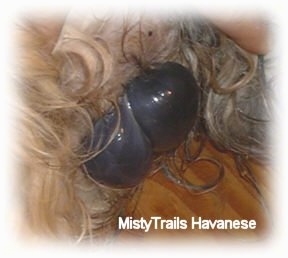
Abnormal presentation of two sacs
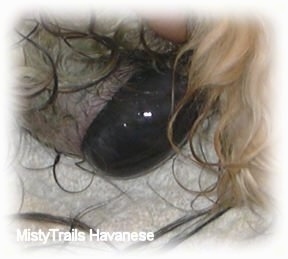
Normal presentation of one sac
Feathering
You can have an extremely easy delivery, right out of the book, but you may also have situations which require experience. Sometimes you have to stimulate the contractions if she pushes so long that she isn't contracting any longer. Doing that is called feathering. You can bring on and stimulate contractions. It is done by putting your finger in the birth canal and stroking inside on the top under her tail with your finger.
Put your gloved and lubed pointer finger into her as far as you can. With your palm up do with your finger what you would do if you were signaling someone to come to you rolling your finger back with the "come here" finger motion. Rake the bottom of the spine inside of her. Press up and push as you bring your finger towards the exit. If she is in labor and has been having contractions this will bring them on harder.
Your dam could be progressing normally, deliver two pups, and then shut down. So after three hours and no pups, and no contractions, you need to guess as to whether everything is okay, and she is having a rest (which can be normal) or if there is a problem (time to call the vet). With a recent litter, after three hours of nothing, we went to the vet, we got a shot of oxytocin, and that made a small contraction. We did another shot of oxytocin under vet care, and still only a small contraction. The contractions were not pushing the puppies down to the birth canal. We both decided it was time for a C-section, knowing that we could be interfering with nature, and she could start up again. Once the C-section was complete, the vet informed me that the C-section was necessary, and that her contractions had pushed two pups out, and two forward. The two that had moved forward were so far up that she would not have gotten them out. Decisions like this are sometimes hard to make, but it sure feels good in the end, when you called for professional veterinary help. Remember, if something doesn't seem right, CALL your VET.
Premature delivery: Pups born before day 58 have a low survival rate, as the lungs are not developed.
This is a puppy still in the sac; it had just come out when the picture was taken. This particular whelping was a VERY difficult delivery, however all the pups are doing well. The first pup was stuck in a breech position. The dam pushed for two hours. All I had was feet. I called the vet, nearly went in at 1 a.m., but I used Joe lube, syringed the lube inside her, and pulled. Pup number three I am gonna call Joe, as he was stuck the worst, but his head was out. They were seven-ounce puppies, which are hard for a seven-pound dam to get out. Last one born was a breeze. The dam is happy, all is well. I will try and sleep.
C-sections are always the last resort, and are sometimes unavoidable, like if two pups try to come out at once, or the puppies are too large to pass through, or if the dam is just too exhausted to carry on after failing to pass puppies. There are a wide variety of problems you may be confronted with. Keep your vet posted of progress. Do NOT hesitate to call the vet if you have questions. You are dealing with life and death and it is better to take all precautions. Do not feel guilty calling on your vet several times if you are unsure of what to do. He is the professional. On Day 58 you should start taking the Dams temperature three times per day. A dam’s temperature will drop from the normal 101.4 to 98+ degrees when the first stage of labor begins. Hard labor usually begins within 24 hours of this temperature drop.
As soon as you know your dam is in pre-labor, it is wise to contact your vet to make sure he is on call. There are so many scenarios that could play out. In case of anything out of the ordinary, consult your vet. This section is here to let you know that you can have six different litters, and be given six different scenarios. Some books say do not let your pup have heavy contractions for more than half an hour without producing a pup, some say three hours. Some say four. Each whelping is different. You cannot put time limits on it, as every situation is different. You must study and know the warning signs of problems—there are many. If something doesn't seem right, contact your vet. "Sooner is better than later."
Even after the whelping is finished, problems can come. A new mom may have doubts about these puppy things, especially if she had a hard whelping.
The faster you get all the pups nursing the better. They will get the needed colostrum, and the dam will produce hormones that will actually turn her into a better loving mom. Keep her fluids up, and give her a bowl of warm broth. Some puppies do not take to nursing; BE PREPARED to be up around the clock. For feeding a slow starting puppy that just will not nurse, have Canine Puppy milk replacer on hand. Hand-feeding one puppy happens, but you also must prepare for feeding an entire orphaned litter, just in case.
We have found that if you need to supplement a newborn puppy, (one that is premature in development and cannot nurse or born very dehydrated) you should ONLY give the pup hand expressed colostrum and or oral rehydrate solution of water, salt and sugar or baby pedialyte, not milk replacer for the first 24 hours.
Are you prepared to do this as a breeder??? There are so many questions to ask yourself before you breed your dam, as very frequently things go wrong, and being prepared and educated can save your dam and puppies’ lives.
Here are photos of two pups being born, one breech and the other normal
Day 60—temp dropped to 98° at 2 p.m…. So I knew in about 24 hours contractions would start. I was up all night.
At 2:30 a.m. she started crying, grunting, panting and frantically nesting.
At 3:00 p.m. she vomited and contractions became quite noticeable.
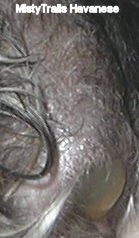
At 6:00 p.m. she started pushing puppy # 1 (the largest puppy). There was presentation of the puppy's water sac.
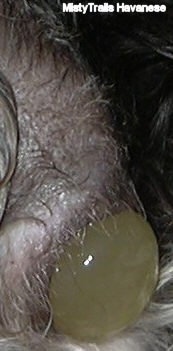
One hour is usually the limit for pushing on a single puppy. She pushed>> it came out a little, and then kept going back in. It was a big 7.5-ounce plug.
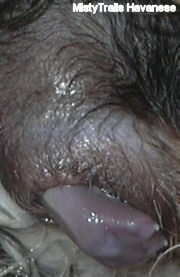
It didn't help when the dam broke the sac and out came only one foot the next push (one foot is not good). So I pushed the one foot back in and feathered the birth canal to stimulate a contraction—because she was not contracting anymore, I was able to get both feet in the birth canal—and kept stimulating contractions with my finger, and on the next contraction, I managed to grab both feet, and pulled towards the dam’s head, along her stomach…. And out he came…with a fair bit of discomfort to poor Mama. Being out of the water sac, and given the situation, I was expecting to have to revive this puppy, but happily he came out strong and thriving....
If after the dam has strained for some time only one foot appears, like the above picture, suggesting that the pup is in an abnormal position, an inexperienced person should NOT attempt to remove the pup. Call your vet. Any delay could risk the life of the puppy and the dam. In an emergency, and when there is no time to get to the vet, the only helpful action is to attempt to push the pup back beyond the neck of the womb, in the hope that the puppy may get into a better position, or to grasp both feet.
It is very important to know how to revive puppies and get them breathing. Not all puppies come out, cry and start breathing. This also takes experience. Puppies need to be rubbed vigorously till they cry and start moving. Some are born and cry easily, but very often they need extra help, and it sure feels good when you know what to do. You will need to get your vet to show you how to get the fluid out of the pup’s nose and throat. A centrifugal force drop done by swinging the puppy down between your legs (holding head VERY secure) is a very useful tool to learn. You do not shake the puppy, nor flick it. The movement is not jerky, but a smooth down-swing with a slow stop. Constant exchanging of warm blankets is also needed. If puppies get chilled in the first days of life, there is a good chance they will not survive. The box needs to be 85 degrees. Puppies are very susceptible to heat/cold. Have your heat pad on, and hot water bottles filled.
Normal Whelping
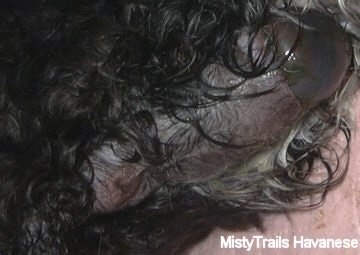
Presentation of puppy #2 (1/2 hour later) normal presentation, head first.
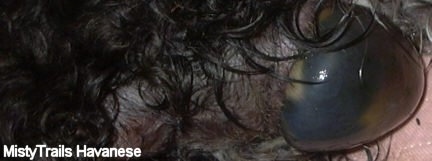
Presentation of puppy #2 - normal birth
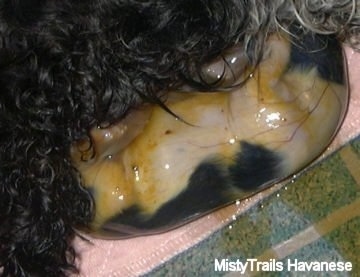
Puppy #2 is born
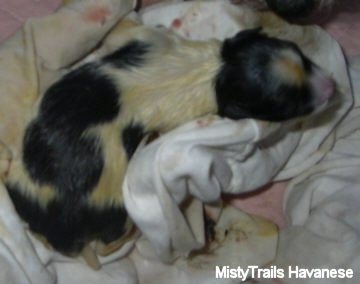
Basically as soon as the pup is out, REMOVE the sac from the head. I do ALL cord care, as the dams are too aggressive, and cut them too short.
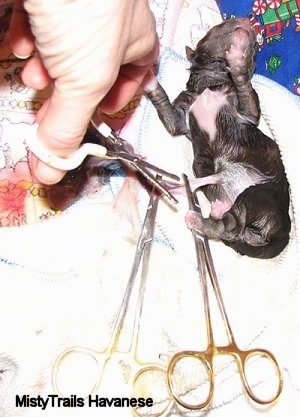
If the pup is out, and the placenta is still inside, you need two hemostats.
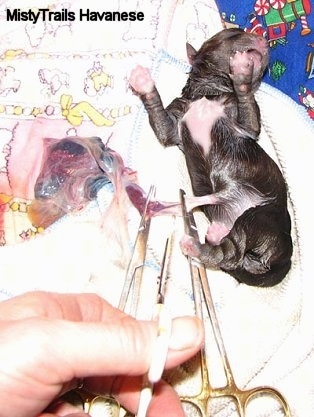
Clamp the two hemostats on, and cut between them with scissors. THEN, one pair will stay hanging out of the dam, and the other pair will be on the puppy.
These three photos show cord clamping, BUT the placenta is out. REMEMBER, the placenta does not always come with the puppy; it may come two to 50 minutes later.
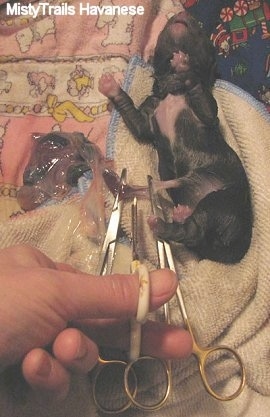
An owner went to the vet, as her large-breed dam wouldn't tend to the puppies. The vet gave the dam a tranquilizer, the dam went home and killed two puppies. In my opinion, you NEVER give a dam a tranquilizer, she should have been given calcium, and that is all.